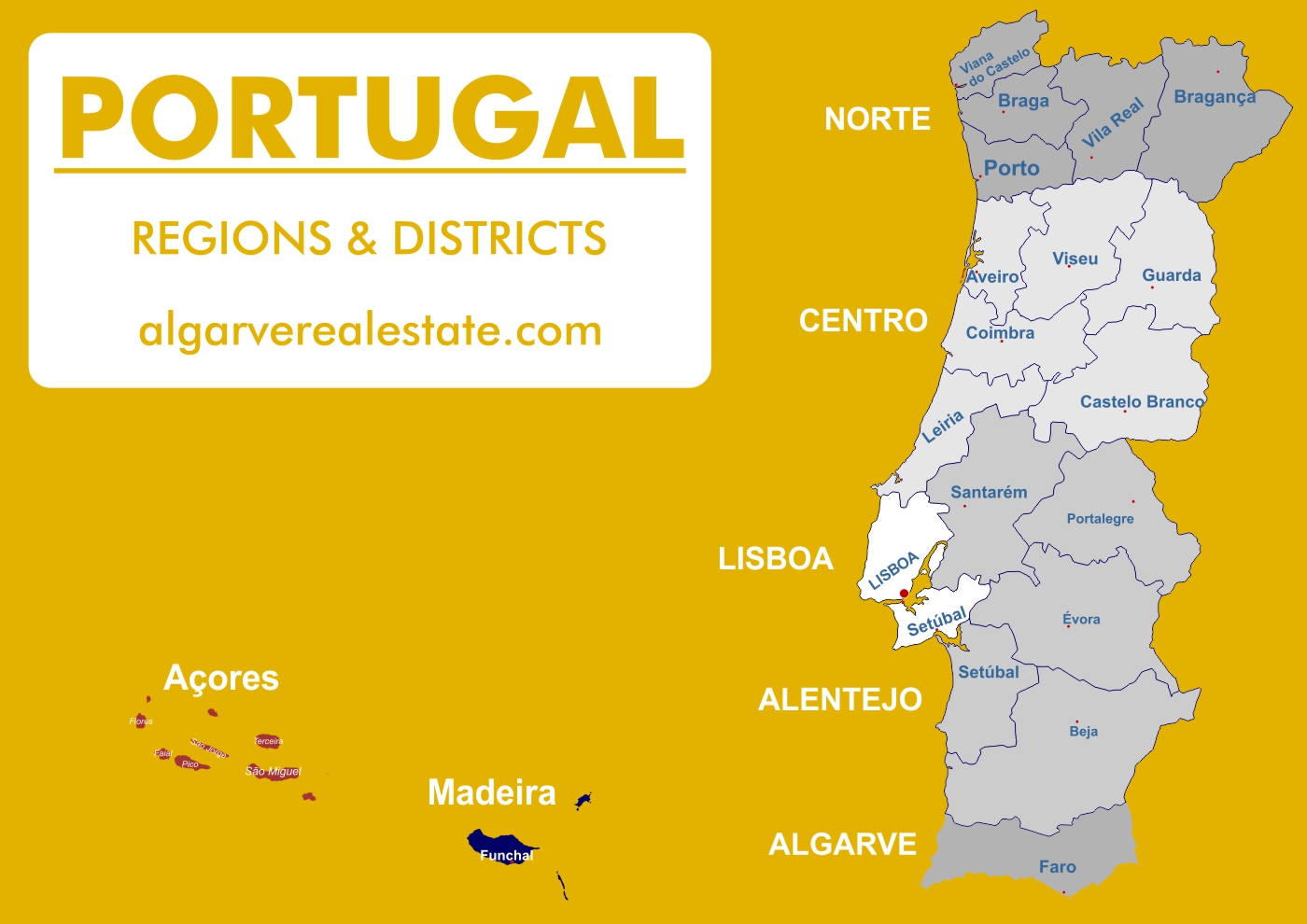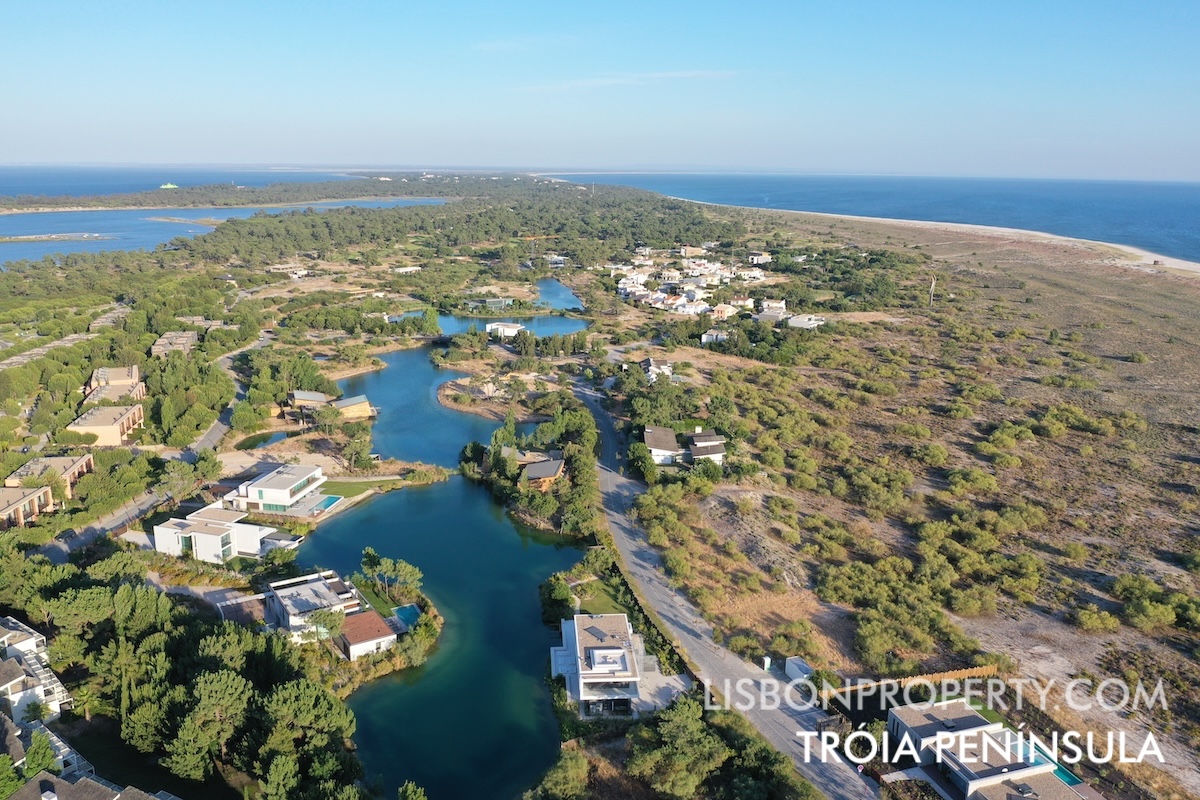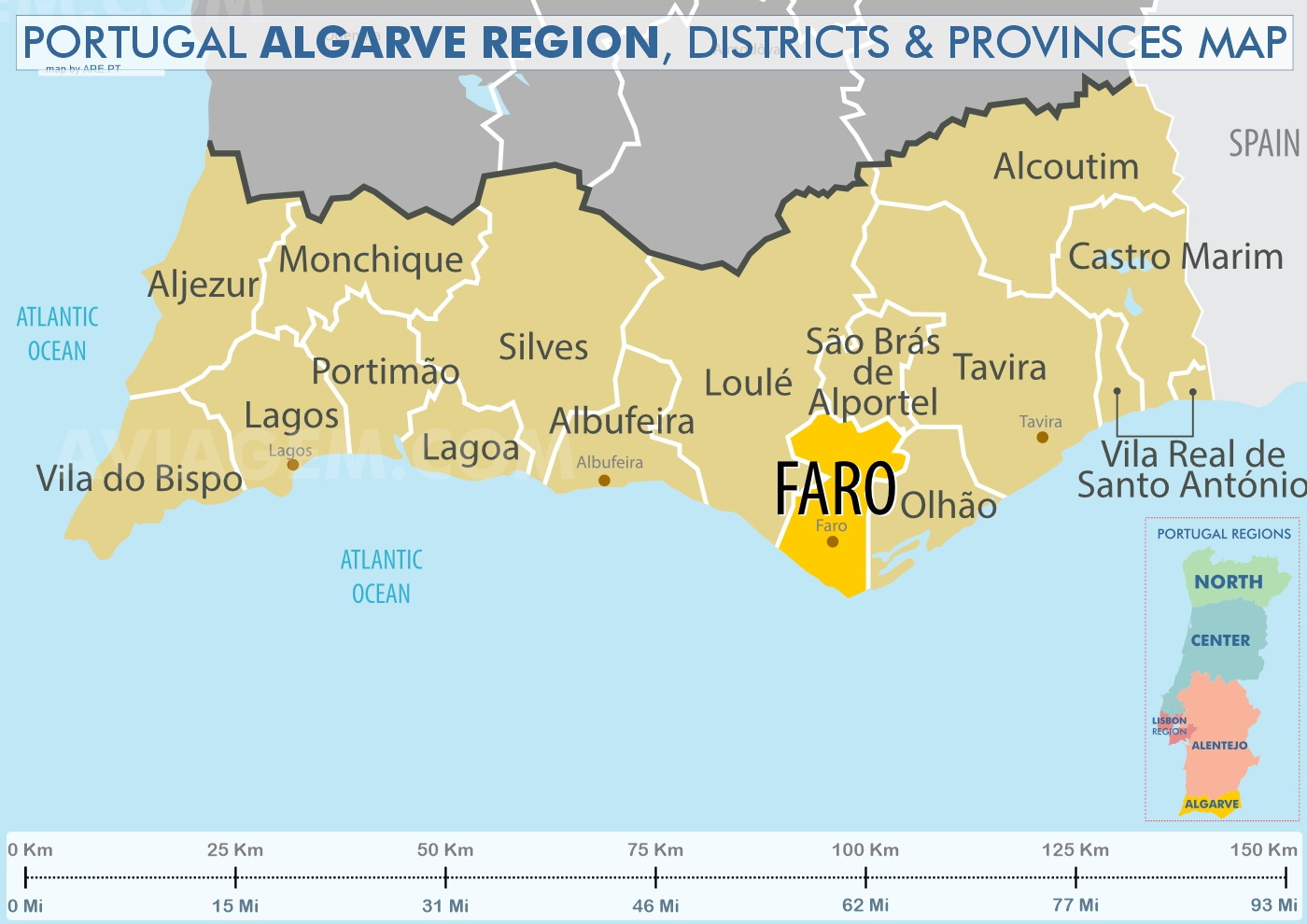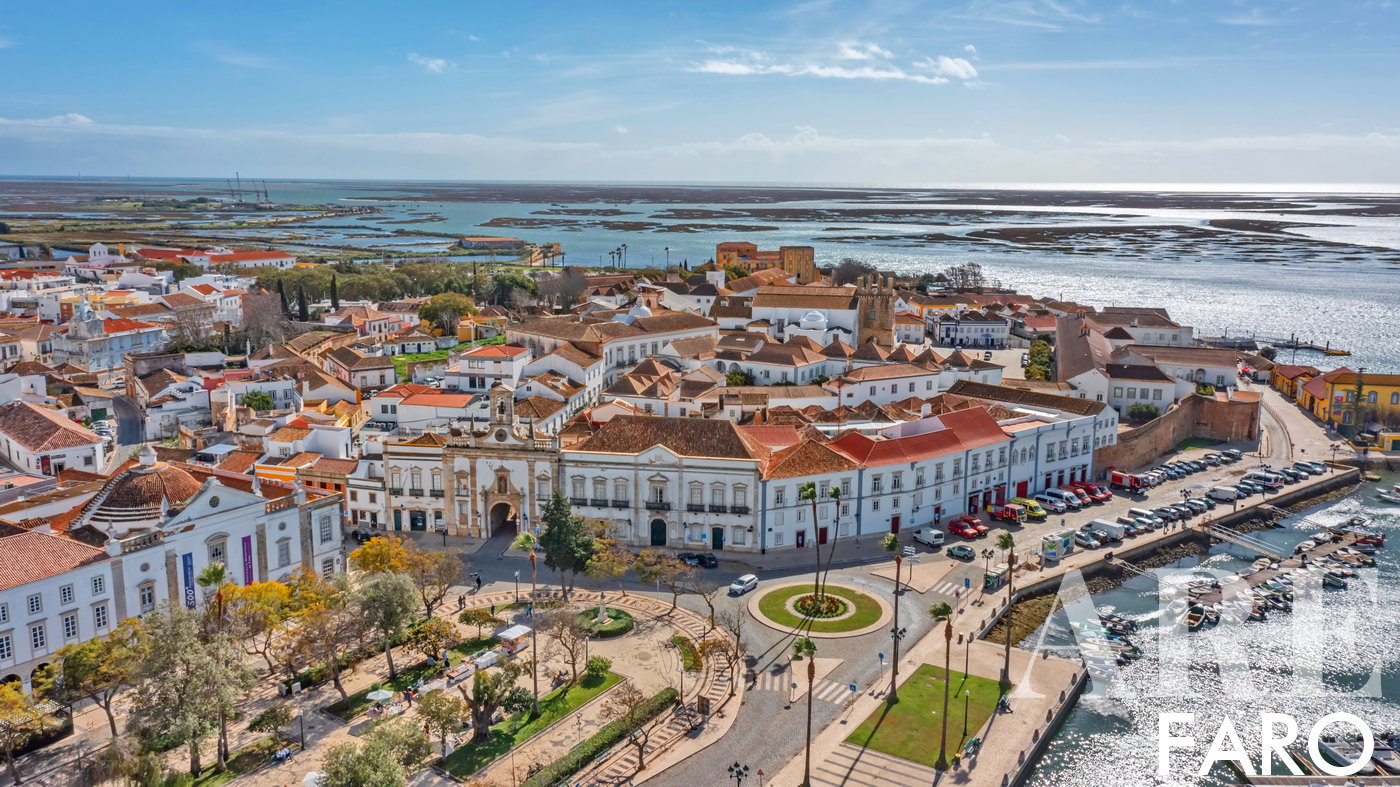Portugal’s 7 regions main features

Map of the regions and districts of Portugal
Portugal is composed of seven distinct regions, each showcasing its own unique characteristics and attractions.
Portugal mainland regions, districts & main cities
Table with the regions of Portugal, their respective districts, and the largest, second-largest, third-largest, and fourth-largest cities in each district:
North Region
The North Region of Portugal, known as Norte, features Porto, known for Port wine, the mountainous Peneda-Gerês National Park, the terraced vineyards of the UNESCO-listed Douro Valley, and a robust industrial sector including textiles, footwear, and manufacturing. Norte districts are Viana do Castelo, Braga, Vila Real, Bragança, and Porto.
| District | Largest City | Second-largest City | Third-largest City | Fourth-largest City |
|---|---|---|---|---|
| Viana do Castelo | Viana do Castelo | Ponte de Lima | Valença | Monção |
| Braga | Braga | Guimarães | Barcelos | Vila Nova de Famalicão |
| Porto | Porto | Vila Nova de Gaia | Matosinhos | Maia |
| Vila Real | Vila Real | Chaves | Peso da Régua | Ribeira de Pena |
| Bragança | Bragança | Mirandela | Macedo de Cavaleiros | Vimioso |
| Aveiro | Aveiro | Ovar | Espinho | São João da Madeira |
No Results Found
The page you requested could not be found. Try refining your search, or use the navigation above to locate the post.
Centro Region
The Centro region is known for the city of Coimbra, with its historic university designated as a UNESCO World Heritage Site. The Serra da Estrela, the highest mountain range in mainland Portugal. Aveiro, referred to as the ‘Venice of Portugal’, Nazaré, renowned for its giant waves. Center inland, the site of Fátima is one of Portugal’s main attraction. Centro districts are Aveiro, Viseu, Guarda, Coimbra, Castelo Branco, and Leiria
| District | Largest City | Second-largest City | Third-largest City | Fourth-largest City |
|---|---|---|---|---|
| Coimbra | Coimbra | Figueira da Foz | Pombal | Lousã |
| Viseu | Viseu | Lamego | Tondela | Mangualde |
| Guarda | Guarda | Seia | Gouveia | Pinhel |
No Results Found
The page you requested could not be found. Try refining your search, or use the navigation above to locate the post.
Lisbon Metropolitan Region
The Lisbon and Tagus Valley region, centered around Portugal’s capital, Lisbon, is known for its rich history, cultural significance, and economic importance. The region features the Tagus River estuary, which has historically been a hub for maritime activities and trade. Lisbon itself offers a mix of traditional architecture, contemporary culture, and vibrant nightlife. The region also encompasses towns like Sintra and Cascais. Lisbon districts are Lisbon and Setúbal.
| District | Largest City | Second-largest City | Third-largest City | Fourth-largest City |
|---|---|---|---|---|
| Lisboa | Lisbon | Sintra | Amadora | Cascais |
| Santarém | Santarém | Tomar | Entroncamento | Rio Maior |
| Setúbal | Setúbal | Almada | Barreiro | Montijo |
Tróia Peninsula
The Península de Troia: is a strip of light sand that stretches for 17 kilometers, surrounded by the ocean, in the municipality of Grândola, district of Setúbal. This peninsula stands out for its natural beauty, being famous for its quiet beaches, Roman remains and...
Almada
Almada is a city located south of Lisbon, on the other side of the 25 de Abril Bridge. The city itself has a population of inhabitants, in a municipality with inhabitants. It is very busy and crowded. People...
Seixal
Barreiro
Palmela
Palmela village Palmela is a Portuguese village in the district of Setúbal. The town and municipality has a population of people. In the locality, we find the Castelo de Palmela as the main attraction of the village, the Casa Mãe da Rota...
Moita
Montijo
Sesimbra
Sesimbra village Sesimbra is a town in Portugal with about people. It is divided into three parishes: Castelo, Quinta do Conde, and Santiago. The town is in the Setúbal District, at the base of the Serra da Arrábida mountains. It is near...
Santiago do Cacém
The attractions of Santiago do Cacém Santiago do Cacém in Setúbal, it is a city with several points of historical and natural interest. Local attractions are made up of the Castelo de Santiago do Cacém where we find the mother church dating from the 13th century, the...
Alcochete
Alcochete Alcochete is a riverside municipality with inhabitants, located on the south side of Lisbon, in front of Parque das Nações, separated by the Natural Reserve of the Tagus Estuary, was populated since the Neolithic period, and...
Alentejo Region
The Alentejo region is known for its expansive agricultural landscapes, low population density, significant wine production, historical towns, and traditional cork oak forests. It is one of the largest regions in Portugal, covering a third of the country, and is recognized for its cultural heritage, with numerous castles and Roman ruins, as well as its slow-paced lifestyle and distinctive cuisine. Alentejo districts are Portalegre, Évora, and Beja
| District | Largest City | Second-largest City | Third-largest City | Fourth-largest City |
|---|---|---|---|---|
| Portalegre | Portalegre | Elvas | Ponte de Sor | Campo Maior |
| Évora | Évora | Montemor-o-Novo | Estremoz | Reguengos de Monsaraz |
| Beja | Beja | Aljustrel | Serpa | Moura |
No Results Found
The page you requested could not be found. Try refining your search, or use the navigation above to locate the post.
Algarve, Portugal South Region
The Algarve region is the southernmost part of Portugal and is known for its Mediterranean beaches, golf resorts, and tourism-oriented services. The region’s mild climate, attractive coastline, and abundant sunshine make it a favorite destination for vacationers.
The Algarve region is the southernmost part of Portugal, famous for its luxury resorts, the marinas, the Ria Formosa, the 37 golf courses, the Sagres fortress, 133 sunny beaches, and lively summer nightlife. The Algarve consists of the single district of Faro.
| District | Largest City | Second-largest City | Third-largest City | Fourth-largest City |
|---|---|---|---|---|
| Faro | Faro | Albufeira | Portimão | Loulé |
Lagos
Tavira
Lagoa
Alcoutim
Vila Real de Santo António
São Brás de Alportel
Algarve
Living in Algarve Go to Properties for sale in Algarve Go to Residential developments in Algarve Algarve, Portugal South Region The Algarve region is the southernmost part of Portugal and is known for its Mediterranean beaches, golf resorts, and tourism-oriented...
Faro
Faro, Algarve region capital city Faro is the administrative capital of the Algarve, presenting itself as an ancient city, full of history, tradition and culture. It has a vast natural and built heritage, with emphasis on the beaches and landscapes of the Ria Formosa....
Portugal includes two autonomous regions, Madeira and the Azores, which are groups of islands located in the Atlantic Ocean.
Azores Autonomous Region
The Azores Autonomous Region is an archipelago situated in the North Atlantic Ocean. The Azores are known for their dramatic landscapes, which include rugged cliffs, green pastures, and crater lakes. The islands are also recognized for their rich marine life, opportunities for whale watching, hot springs, and outdoor activities like hiking and diving. The Azores also noted for its dairy products, particularly cheese, and for its pineapple plantations. Azores region is made up of nine volcanic islands, divided into three groups: Eastern (São Miguel and Santa Maria), Central (Terceira, Graciosa, São Jorge, Pico, and Faial), and Western (Flores and Corvo).
| Island Group | Largest City | Second-largest City | Third-largest City | Fourth-largest City |
|---|---|---|---|---|
| São Miguel | Ponta Delgada | Ribeira Grande | Lagoa | Vila Franca do Campo |
| Terceira | Angra do Heroísmo | Praia da Vitória | — | — |
| Pico, Faial, and others | Horta (Faial) | Madalena (Pico) | Velas (São Jorge) | — |
No Results Found
The page you requested could not be found. Try refining your search, or use the navigation above to locate the post.
Madeira Autonomous Region
The Madeira Autonomous Region is an archipelago distinguished by its rugged landscape and a network of levadas, which are irrigation channels designed to distribute water throughout the island’s agricultural areas. The region is characterized by its subtropical climate, verdant gardens, the renowned Madeira wine, and the colorful annual Madeira Flower Festival. The Madeira region comprises two inhabited main islands, Madeira and Porto Santo, and two groups of uninhabited islands, the Desertas and Selvagens.
| Island | Largest City | Second-largest City | Third-largest City | Fourth-largest City |
|---|---|---|---|---|
| Madeira | Funchal | Câmara de Lobos | Santa Cruz | Machico |
| Porto Santo | Vila Baleira | — | — | — |
No Results Found
The page you requested could not be found. Try refining your search, or use the navigation above to locate the post.




